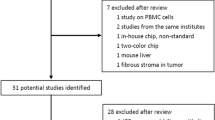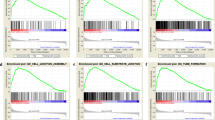Abstract
The conventional gene expression profiling approaches have been replaced with DNA microarrays with exhibiting a powerful high-throughput capacity. Most solid surfaces of DNA microarrays contain such a high area density of functional groups to immobilize capture DNAs to the surface that the hybridization of capture DNAs with cDNA can be hindered, resulting in low intensity and reproducibility. Since our previous works showed that the 9-acid dendron was able to increase the hybridization efficiency, we aimed to demonstrate the feasibility of 9-acid dendron-coated glass slides as an advanced microarray platform for gene expression profiling. The 9-acid dendron-coated DNA microarray could reproducibly obtain the expression levels of 2800 human cancer-associated genes in the two liver cancer lines: Hep3B and SK-Hep1. Among the differentially expressed genes, Caveolin-1 (Cav-1) was identified as the most highly up-regulated gene in invasive SK-Hep1 in comparison to non-motile Hep3B. The overexpression of Cav-1 in Hep3B promoted the cell invasion, whereas its knockdown in SK-Hep1 suppressed the invasive feature, which confirms that the overexpression of Cav-1 is closely associated with cell invasion of liver carcinoma. Collectively, the 9-acid dendron-coated surface could successfully detect the transcript levels of cells, demonstrating its feasible potential to identify the candidate genes for further functional studies or diagnosis of diseases.




Similar content being viewed by others
Abbreviations
- cDNA:
-
Complementary DNA
- Cav-1:
-
Caveolin-1
- DEG:
-
Differentially expressed gene
- DMSO:
-
Dimethyl sulfoxide
- EDTA:
-
Ethylenediaminetetraacetic acid
- EMT:
-
Epithelial-mesenchymal transition
- FBS:
-
Fetal bovine serum
- NHS:
-
N-hydrosuccinylimide
- PAGE:
-
Polyacrylamide gel electrophoresis
- PBS:
-
Phosphate-buffered saline
- PMT:
-
Photomultiplier tube
- qPCR:
-
Quantitative real-time PCR
- SAM:
-
Significance analysis of microarrays
- SD:
-
Standard deviation
- SDS:
-
Sodium dodecyl sulfonate
- siRNA:
-
Small interfering RNA
- SSC:
-
Saline sodium citrate
- TEM:
-
Transmission electron microscopy
- Vim:
-
Vimentin
References
Schena, M., Shalon, D., Davis, R. W., & Brown, P. O. (1995). Quantitative monitoring of gene-expression patterns with a complementary-DNA microarray. Science, 270(5235), 467–470.
International Human Genome Sequencing, C. (2004). Finishing the euchromatic sequence of the human genome. Nature, 431(7011), 931–945.
Duffy, M. J., McGowan, P. M., & Gallagher, W. M. (2008). Cancer invasion and metastasis: changing views. The Journal of Pathology, 214(3), 283–293.
Hanahan, D., & Weinberg, R. A. (2011). Hallmarks of cancer: the next generation. Cell, 144(5), 646–674.
van't Veer, L. J., Dai, H., van de Vijver, M. J., He, Y. D., Hart, A. A., Mao, M., Peterse, H. L., van der Kooy, K., Marton, M. J., Witteveen, A. T., Schreiber, G. J., Kerkhoven, R. M., Roberts, C., Linsley, P. S., Bernards, R., & Friend, S. H. (2002). Gene expression profiling predicts clinical outcome of breast cancer. Nature, 415(6871), 530–536.
Yamaguchi, H., Wyckoff, J., & Condeelis, J. (2005). Cell migration in tumors. Current Opinion in Cell Biology, 17(5), 559–564.
Lin, A. Y., Chua, M. S., Choi, Y. L., Yeh, W., Kim, Y. H., Azzi, R., Adams, G. A., Sainani, K., van de Rijn, M., So, S. K., & Pollack, J. R. (2011). Comparative profiling of primary colorectal carcinomas and liver metastases identifies lef1 as a prognostic biomarker. PloS One, 6(2), e16636.
Nimse, S. B., Song, K., Sonawane, M. D., Sayyed, D. R., & Kim, T. (2014). Immobilization techniques for microarray: challenges and applications. Sensors, 14(12), 22208–22229.
Kim, E. S., Hong, B. J., Park, C. W., Kim, Y., Park, J. W., & Choi, K. Y. (2011). Effects of lateral spacing on enzymatic on-chip DNA polymerization. Biosensors and Bioelectronics, 26(5), 2566–2573.
Kim, E. S., Kim, J. S., Lee, Y., Choi, K. Y., & Park, J. W. (2012). Following the DNA ligation of a single duplex using atomic force microscopy. ACS Nano, 6(7), 6108–6114.
Kim, E. S., Lee, N., Park, J. W., & Choi, K. Y. (2013). Kinetic characterization of on-chip DNA ligation on dendron-coated surfaces with nanoscaled lateral spacings. Nanotechnology, 24(40), 405703.
Oh, S. J., Ju, J. M., Kim, B. C., Ko, E., Hong, B. J., Park, J. G., Park, J. W. and Choi, K. Y. (2005). DNA microarrays on a dendron-modified surface improve significantly the detection of single nucleotide variations in the p53 gene. Nucleic Acids Research, 33 (10).
Kim, Y., Kim, E. S., Lee, Y., Kim, J. H., Shim, B. C., Cho, S. M., Lee, J. S., & Park, J. W. (2014). Reading single DNA with DNA polymerase followed by atomic force microscopy. Journal of the American Chemical Society, 136(39), 13754–13760.
Eun, J. R., Jung, Y. J., Zhang, Y., Zhang, Y., Tschudy-Seney, B., Ramsamooj, R., Wan, Y. J., Theise, N. D., Zern, M. A., & Duan, Y. (2014). Hepatoma SK Hep-1 cells exhibit characteristics of oncogenic mesenchymal stem cells with highly metastatic capacity. PloS One, 9(10), e110744.
Kim, J. R., & Kim, C. H. (2004). Association of a high activity of matrix metalloproteinase-9 to low levels of tissue inhibitors of metalloproteinase-1 and -3 in human hepatitis B-viral hepatoma cells. The International Journal of Biochemistry & Cell Biology, 36(11), 2293–2306.
Hong, B. J., Oh, S. J., Youn, T. O., Kwon, S. H., & Park, J. W. (2005). Nanoscale-controlled spacing provides DNA microarrays with the SNP discrimination efficiency in solution phase. Langmuir, 21(10), 4257–4261.
Bolstad, B. M., Irizarry, R. A., Astrand, M., & Speed, T. P. (2003). A comparison of normalization methods for high density oligonucleotide array data based on variance and bias. Bioinformatics, 19(2), 185–193.
Tusher, V. G., Tibshirani, R., & Chu, G. (2001). Significance analysis of microarrays applied to the ionizing radiation response. Proceedings of the National Academy of Sciences of the United States of America, 98(9), 5116–5121.
Hwang, D., Rust, A. G., Ramsey, S., Smith, J. J., Leslie, D. M., Weston, A. D., de Atauri, P., Aitchison, J. D., Hood, L., Siegel, A. F., & Bolouri, H. (2005). A data integration methodology for systems biology. Proceedings of the National Academy of Sciences of the United States of America, 102(48), 17296–17301.
Tse, E. Y. T., Ko, F. C. F., Tung, E. K. K., Chan, L. K., Lee, T. K. W., Ngan, E. S. W., Man, K., Wong, A. S. T., Ng, I. O. L., & Yam, J. W. P. (2012). Caveolin-1 overexpression is associated with hepatocellular carcinoma tumourigenesis and metastasis. The Journal of Pathology, 226(4), 645–653.
Kim, K. R., Choi, H. N., Lee, H. J., Baek, H. A., Park, H. S., Jang, K. Y., Chung, M. J., & Moon, W. S. (2007). A peroxisome proliferator-activated receptor gamma antagonist induces vimentin cleavage and inhibits invasion in high-grade hepatocellular carcinoma. Oncology Reports, 18(4), 825–832.
Tarca, A. L., Romero, R., & Draghici, S. (2006). Analysis of microarray experiments of gene expression profiling. American Journal of Obstetrics and Gynecology, 195(2), 373–388.
Choi, Y. S., Yoon, C. W., Lee, H. D., Park, M., & Park, J. W. (2004). Efficient protein-ligand interaction by guaranteeing mesospacing between immobilized biotins. Chemical Communications, 11, 1316–1317.
Cokakli, M., Erdal, E., Nart, D., Yilmaz, F., Sagol, O., Kilic, M., Karademir, S., & Atabey, N. (2009). Differential expression of caveolin-1 in hepatocellular carcinoma: correlation with differentiation state, motility and invasion. BMC Cancer, 9, 65.
Gagescu, R. (2001). Life without caveolae. Nature Reviews Molecular Cell Biology, 2(11), 788–788.
Liu, P. S., Rudick, M., & Anderson, R. G. W. (2002). Multiple functions of caveolin-1. Journal of Biological Chemistry, 277(44), 41295–41298.
Sotgia, F., Martinez-Outschoorn, U. E., Howell, A., Pestell, R. G., Pavlides, S., & Lisanti, M. P. (2012). Caveolin-1 and cancer metabolism in the tumor microenvironment: markers, models, and mechanisms. Annual Review of Pathology: Mechanisms of Disease, 7, 423–467.
Senetta, R., Stella, G., Pozzi, E., Sturli, N., Massi, D., & Cassoni, P. (2013). Caveolin-1 as a promoter of tumour spreading: when, how, where and why. Journal of Cellular and Molecular Medicine, 17(3), 325–336.
Goetz, J. G., Joshi, B., Lajoie, P., Strugnell, S. S., Scudamore, T., Kojic, L. D., & Nabi, I. R. (2008). Concerted regulation of focal adhesion dynamics by galectin-3 and tyrosine-phosphorylated caveolin-1. Journal of Cell Biology, 180(6), 1261–1275.
Yao, Z. X., & Mishra, L. (2009). Cancer stem cells and hepatocellular carcinoma. Cancer Biology & Therapy, 8(18), 1691–1698.
Acknowledgements
This research was supported by Basic Science Research Program through the National Research Foundation (NRF) of Korea funded by the Ministry of Science, ICT and Future Planning (grant number NRF-2015R1C1A1A01052498 to ESK). This study was also financially supported by Chonnam National University (grant number 2015-1847 to ESK); an NRF grant (grant number 2014R1A2A2A01002931 to KYC) funded by the MEST; and the Next-Generation BioGreen 21 Program (grant number PJ01121601 to KYC) of Rural Development Administration, Republic of Korea. Authors thank Ms. Su-Jung Kim at POSTECH Biotech Center for the help with the sample preparation for TEM imaging. We are also grateful to Dr. Mi Nam Lee for her comments on the immunoblotting results.
Author’s Contributions
ESK and KYC conceived and designed the experiments; ESK, JHK, JHS, and SMH performed the experiments; and SY and ESK analyzed the data.
Author information
Authors and Affiliations
Corresponding authors
Ethics declarations
Conflict of Interest
The authors declare that they have no conflict of interest.
Electronic supplementary material
ESM 1
(DOCX 187 kb)
Rights and permissions
About this article
Cite this article
Kim, ES., Kwon, J.H., Shin, J.H. et al. Identification of Caveolin-1 as an Invasion-Associated Gene in Liver Cancer Cells Using Dendron-Coated DNA Microarrays. Appl Biochem Biotechnol 182, 1276–1289 (2017). https://doi.org/10.1007/s12010-017-2398-3
Received:
Accepted:
Published:
Issue Date:
DOI: https://doi.org/10.1007/s12010-017-2398-3




